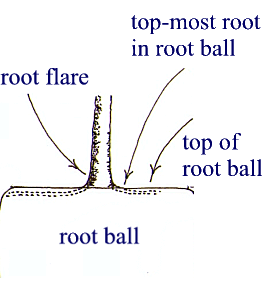Home > Planting trees > Nursery stock selection > Locate the top-most root
Locate the top-most root before planting
The point where the top-most root in the root ball emerges from the trunk should be within two inches of the top surface of the root ball. This zone is often called the root collar, root crown, root flare or trunk flare. There should be no roots circling or crossing over the top-most roots in the root ball. You might have to remove soil above the top-most root during planting to position the flare within 2 inches of the surface. Click here to see the natural root flare on forest and landscape trees.
| Bare
root tree or B&B
The top-most root in the illustration above may be adventitious in nature. If this is the case you might consider removing it, especially if it is small, and plant so the three major original roots are closer to the soil surface. More research is needed to determine appropriate procedure in this case. |
Container
grown tree
Root flare (a swelling at the trunk base) is often visible on trees more than about 4 to 6 inches in caliper but may not be apparent on small trees. The top-most root on quality nursery trees is located within the top 2 inches of the root ball. See: photo. |
How does this happen? Cultivating equipment used along nursery rows can throw soil around tree trunks and on top of the roots. This raises the soil level over the root system in the nursery and essentially buries the roots too deep. Trees can also be planted too deep in the field or in containers creating the same problem. When the nursery crew harvest the tree as a B&B root ball, this soil or media without roots can sometimes make up the top quarter of the root ball, or more in extreme cases. This is not a good practice and it is not recommended because this additional soil cuts off oxygen to the roots and can cause trunk rot where moist soil contacts bark. You will also notice that even though the root ball is sized appropriately, a smaller root system is harvested on a tree with soil on top of the root ball. The undersized root system places additional stresses on the tree. The top-most root on quality nursery trees is located within the top 2 inches of the root ball. Soil could also shift during transport resulting in an inch or two of soil movement up the trunk.
What can you do? If there is a small amount of soil over the root ball, less than about 2 inches, then plant the tree a few inches high in the landscape. Check for and cut circling roots by displacing or removing soil over the top-most roots. If there is more than about 2 inches of soil over the top-most root, remove most of the excess. This may or may not be easy, depending on the tree. When you are done the top-most root should be within the top 2 inches of the soil surface.
What can happen if you do nothing? Trees planted very deep in the nursery could grow well, or they could grow slowly. There is little research in this area so this is poorly understood. Although trees too deep in the root ball sometimes grow fine in the nursery, they can become stressed after planting in the landscape because oxygen is cut off from the roots. They may have been plenty of soil oxygen in the nursery but urban soils can have poor soil aeration. This can cause the plant to die suddenly or slowly decline over a period of years. More information.



